- Bernard Preston homepage
- Starch
- How Do Net Carbs Work
How do net carbs work?
How do net carbs work is an important question so that we can distinguish between those that are making us obese and some that are actually very good for us.
Unless you are a scientist what is required are ballpark-figures. We have no need to know if the net carbs of a dish are 43 or 52; but it's vital that you can ascertain whether it is 163 or 320.
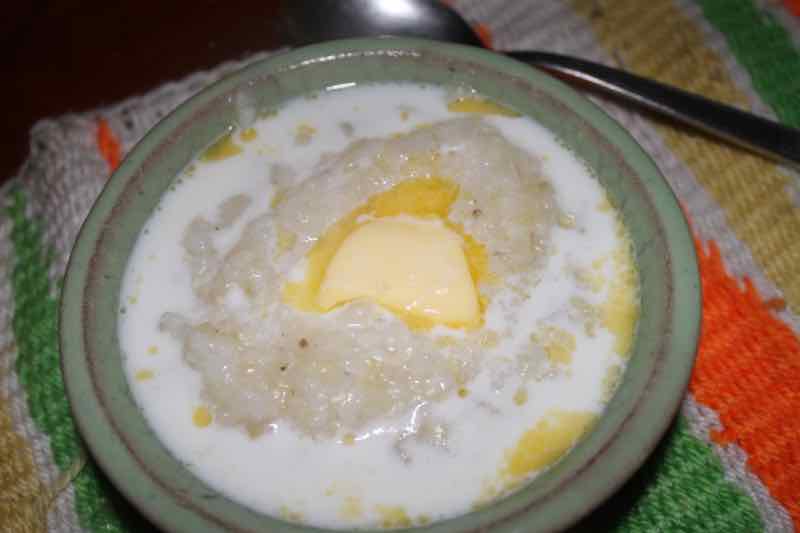
You have probably heard that it is the carbs that are making us obese with some suggesting we should avoid them altogether. But then you read about the strong research that whole grains and legumes are actually very good for us; functional-foods that promote wellness and help us fight disease.
It really is all so confusing; even the so-called experts are poles apart. But don't throw up your hands in horror and give up; apply the mind to how net carbs work and then you will be in a position to make your own decision.
Is this freshly-ground maize meal porridge with added fat good for you or is it just terrible? Should you be avoiding it at all costs?
Butter is back so you can relax on that score; but again it depends on the overall content of the meal.
Calculating net carbs
Net carbs = Total starch minus the indigestible fibre
Simply subtract the grams of fibre from the total weight of the starch and you will get the net carbs.
Don't be alarmed by "indigestible" fibre; it simply means that despite being a long chain of sugar molecules, it is not absorbed into the blood stream as glucose. It passes through to the colon. There it forms the very important prebiotic that is demanded by the friendly microflora. It will not stress your pancreas.
For example that bowl of stone-ground grits above contains about 33g of whole corn, making 200 grams of porridge.
Add fat in the form of cream or cheese to lower the GI even further.
33g of grits (dry weight)
Total carbs
Fibre
Net carbs
Add carbs in 1/4 cup of milk
Grand total
33g
- 5g
= 28g
+3g
= 31g of available carbs in a bowl of whole grain grits with added milk.
For healthy folk 31g of carbs at a sitting is well within the normal limits; for the diabetic and obese, I would recommend a half-size portion. You should stay beneath 50 grams per day; and even less if your blood glucose is unstable.
Add to that Eggs Florentine and you have the perfect diabetic-breakfast; very low in carbs with sufficient protein and fat.
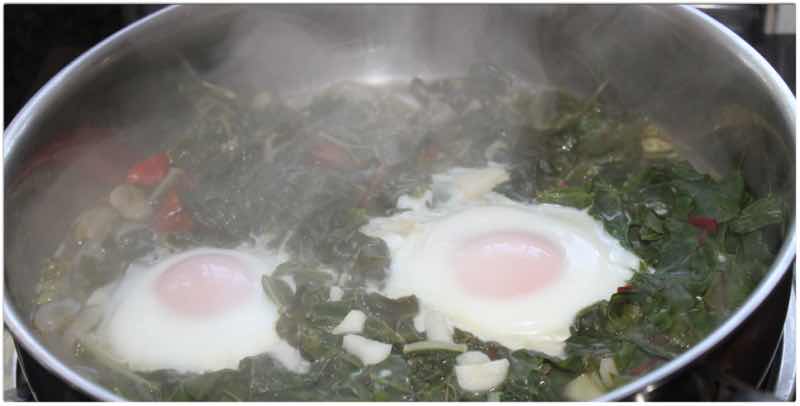 The extremely low carb breakfast.
The extremely low carb breakfast.How do net carbs work?
Add fat such as cream, the protein in milk and cheese to lower the GI of your grits even further; berries to make it interesting.
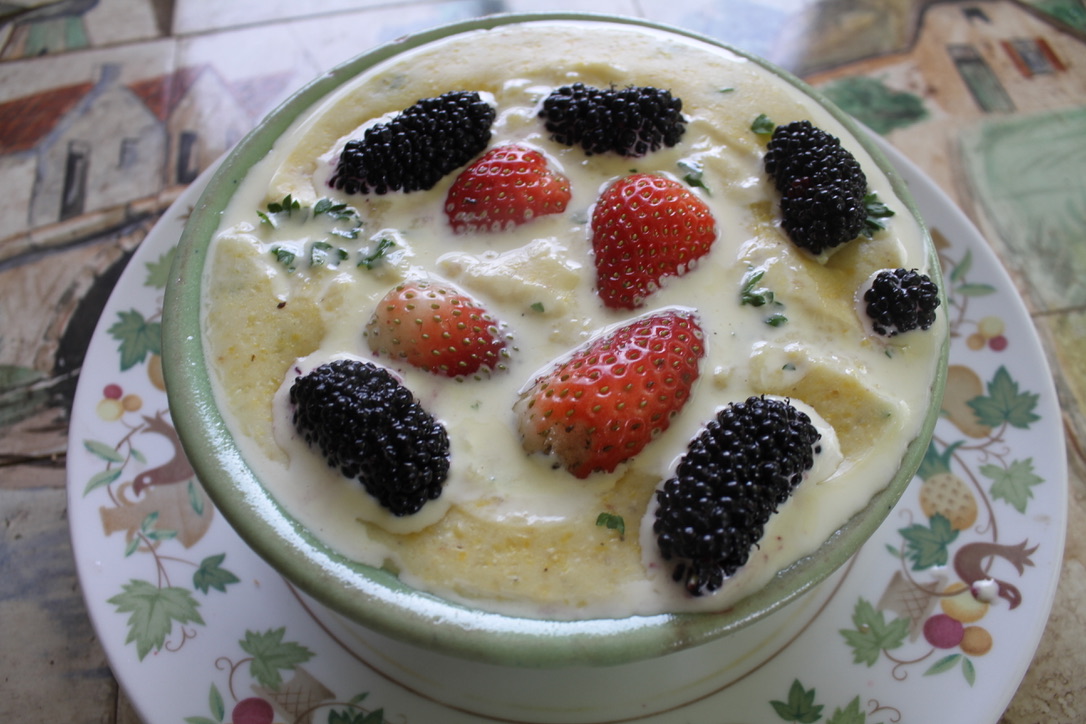 Cheesy stone-ground grits.
Cheesy stone-ground grits.Processed foods
There are two things you should know about me. The first is that I am deeply suspicious of all food-companies. Deep down I expect the worst of them; their primary motive is the bottom line and they don't care a jot about our health.
And the second is that I am absolutely convinced that whole grains, if you can get them and legumes are extremely good for us; both have a lot of starch but the net carbs are on the low side.
- Dr Bernard Preston
Food companies cannot make much money out of us if we only eat whole grains and legumes. But processed meals see an astonishing mark-up in price and almost without exception a severe drop in nutritional benefit.
That bowl of 100pc whole-grain maizemeal porridge is made from 33g of corn which, if you buy it from the farmer, costs R0,11. Yes that's right; just eleven South African cents. Divide by 15 to get the dollar value; a pittance.
The same weight of a bowl of cornflakes[3] would cost about two rands, around a twenty-times markup; and because there is little fibre it is digested very quickly. Worse is that since it tastes like cardboard you will probably add at least one teaspoon of sugar and probably a lot more.
So where do net carbs come into it?
How do net carbs work? I hope you are getting the feel of it.
How do net carbs work?
Understanding how net carbs work will help you get your weight under control. That is the big question; grasp it and you'll realise you need have no fear of unrefined starches.
But cake flour, refined maizemeal and sugar are literally the death of us. All of the fibre has been removed so the net carbs are the same as the total starch. The whole lot is digested and rapidly absorbed in the small intestine giving one a blood-glucose rush.
Esteemed South African scientist, George Campbell, showed that after just twenty years of consuming about 30kg of sugar per year, 21tsp each day, one is highly likely to become diabetic.
One can of a cola contains about 10tsp; half the way to type-2 diabetes.
The average adolescent in South Africa is consuming about 2 cups of sugar; nearly 100 tsp every day[1]; to give ultra-processed, tasteless food some flavour. Is it any wonder we have become truly obese? Officially we are the most unhealthy nation in the world according to certain criteria; certainly in the bottom ten.
How do net carbs work? Central to the question of whether they are good or bad is determined by whether the fibre and germ have been extracted from the cornmeal.
"Intake of sugar appears to be increasing steadily across the South-African population. Children typically consume about 50 grams per day, rising to as much as 100 g in adolescents."
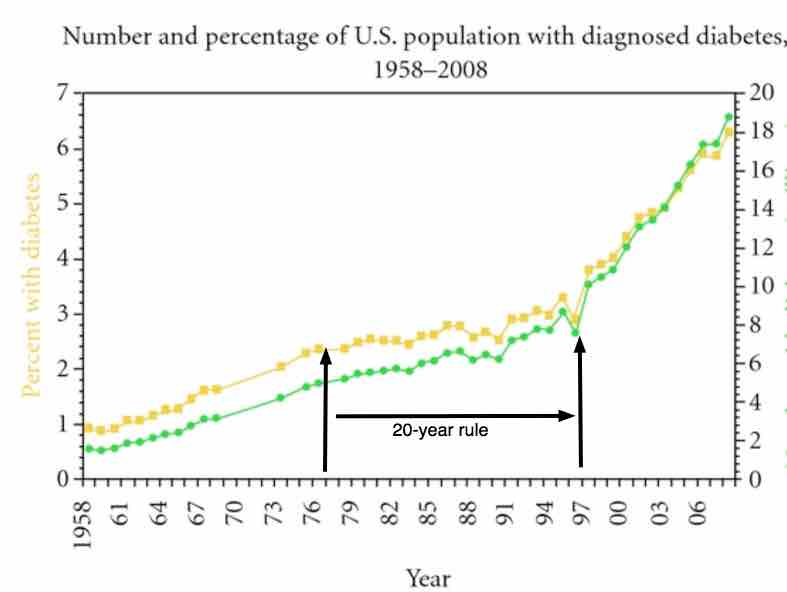
In 1977 in an attempt to reduce cholesterol Americans switched from saturated fats to refined carbs after the McGovern Report was released; within 20 years a tragedy began to unfold.
Net carbs
The net carbs are those that are digested, beginning with the action of amylase in the mouth and then being completely absorbed in the small-intestine. The glucose formed is fed directly to the liver where it is turned either into glycogen or triglycerides.
High blood glucose is very damaging to the linings of capillaries; so if there is suddenly a surge the pancreas releases insulin enabling the cells of a healthy body to absorbe the sugars.
However if there is "insulin resistance" this normal process does not occur properly and blood glucose continues to rise.
These net carbs come in two forms.
- Simple carbs which are made up of one, two and sometimes three glucose molecules. They are found in many foods and are not necessarily bad for us. Examples would be the lactose in milk and fructose in berries; honey and sugar too.
- Complex carbs are those which are found in butternut, potatoes and grains; and legumes too.
This is an extremely complicated and confusing subject. Just take the potato for example. Straight from cold storage the net carbs are very high; depending on the variety and how they are cooked. They will give a blood-glucose surge.
But new potatoes, just dug from the ground have half the amount of net carb. Even many diabetics can eat them provided they keep the glycemic-load down; small portions.
Part of this mystery is because new potatoes are not usually peeled; that's where much of the fibre and nutrients are located.
Honey
Let us think of honey now. Unprocessed straight from the beekeeper it has a low glycemic index, despite consisting of simple sugars. But once heated and processed by the bottlers it is very definitely high GI; it will cause a blood-glucose surge.
Natural honey enjoyed daily actually lowers the fasting blood glucose of diabetics.
We simply cannot presume that all potatoes, corn and honey are bad; or good for that matter. Everything depends on how they have been processed.
How do net carbs work? Unprocessed and unrefined they are good for us. Those who are insulin-resistant will need to limit the portion size.
Indigestible carbs
Indigestible carbs are those which cannot be broken down to glucose and will not be absorbed into the portal blood stream. They provoke no alarming release of insulin, instead passing through to the colon where they are fallen upon by the friendly-flora known as the microbiome.
Most of this indigestible carb consists of the poly-sugar units in fibre. It is extremely good for us.
They are then subtracted from the total starch when calculating the net carbs.
Net carbs = Total starch minus the indigestible fibre
Fibre comes in two forms. The greater part, about two-thirds is insoluble; it will not disperse in the water in the intestine. Instead it gives the stool bulk, helping to prevent constipation and passes through the alimentary canal unchanged; it is indigestible carb and highly beneficial to our wellness. It causes no rise in blood glucose; nor is it fattening in any way.
The bran in unrefined wheat, oats and grits are all examples of the insoluble fibre that millers in the main extract from our grains to our great detriment. It is also where many of the vitamins and phytonutrients are located; the rest are in the germ.
How do net carbs work? I hope it's becoming clear.
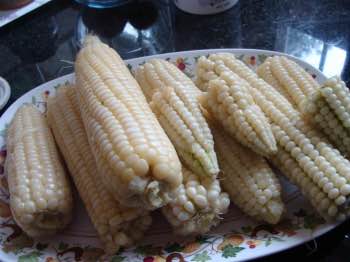
Corn on the cob is one of the few whole grains that is easy to find on the shelves of your greengrocer in season.
A mealie a day, corn on the cob is our joy in the summer; sometimes two or three.
For the rest of the year you have to locate a source of unrefined maizemeal, freshly-ground and it may be well nigh impossible; unless you know someone with a corn flour milling machine.
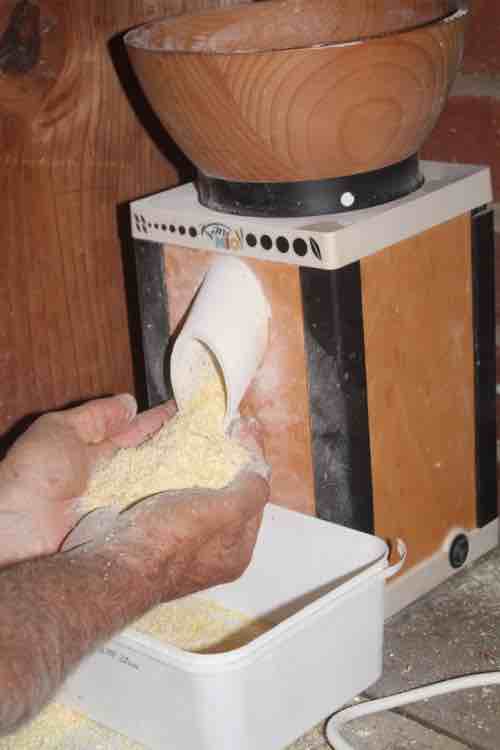
Soluble fibre
The soluble form of indigestible carb is able to disperse in the water in the gut.
Soluble fibre forms a gel in the gut that slows the passage of faeces through the colon so that we do not get diarrhoea; it too is an extremely important carb for our wellness.
Unrefined wholegrain oats and apples are two excellent sources of soluble-fibre; once stripped of their goodness by the milling and juicing companies these foods are quite useless. Buy neither in boxes nor cartons.
 Stone-ground grits is high in fibre.
Stone-ground grits is high in fibre.But what about this best potato latkes recipe ever? Those traditionally made are only for high and holy days; Hanukkah. Avoid them for the rest of the year. But cooked with new potatoes and whole grain flour, you could enjoy them every week. The net carbs are lower but still keep the load down if there is any suggestion of raised blood glucose; only one.
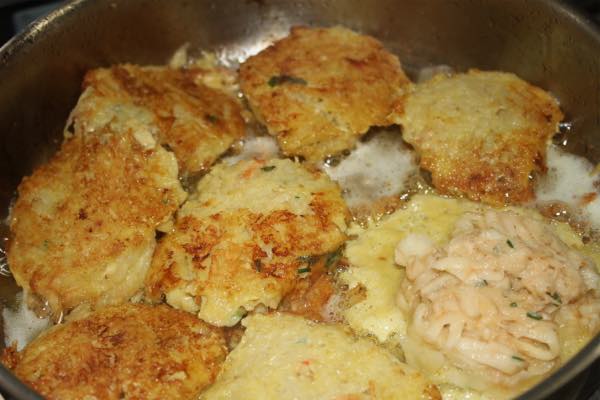 New potatoes are high in resistant starch; net carbs are lower.
New potatoes are high in resistant starch; net carbs are lower.Second brain
You have probably heard that the large intestine is now being called the "second brain." These indigestible fractions of starches and legumes are fermented by the friendly bugs in the colon known as the microbiome forming extremely beneficial "short-chain fatty acids." They not only supply energy to the cells lining the gut but are also involved in the synthesis of many neurotransmitters like dopamine; and support the immune system.
Those with a depleted microbiome, short in either numbers or diversity are thus more likely to get Long Covid; that is why we recommend making and enjoying kefir, a natural probiotic[4]. There are many others to choose from; homemade unpasteurised sauerkraut, for example.
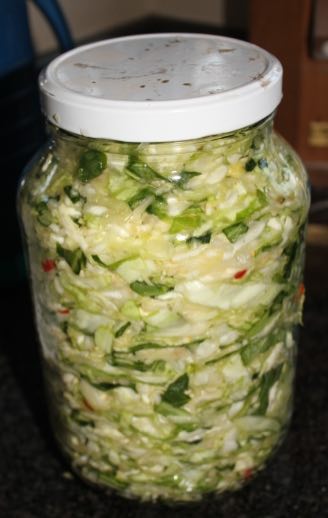
I hope you get it. Despite the bad press they get, not all starches are bad; in fact some are extremely beneficial. But keep the net carbs load down; small helpings.
Scientists have shown that this action of indigestible fibre in the gut, meaning that it does not form glucose, actually has an anti-diabetic influence and helps reduce obesity[2]. Signalling to the brain provides what is known as satiety. It's that sense of fullness; time to stop eating.
How do net carbs work? Grasp this prickly nettle and you'll never have to diet again or suffer from type-2 diabetes; the biggest killer now according to some reports.
In effect you are using food as medicine; researchers have shown that most of those suffering from T2D can bring their condition completely into remission without needing any drugs.
Take home
Not all carbs are bad, only those that have been refined to remove the fibre and other important nutrients; so absolutely avoid instant grits and super number-one refined maizemeal.
In fact unrefined starches, admittedly difficult to get unless you have an uncle in the milling-business and legumes are extremely beneficial to us in moderation.
Having subtracted the grams of indigestible fibre from starchy foods, prediabetics still need to keep the Glycemic Load down; that means small portions.
Net carbs in foods
Food
Avocado
Corn on the cob
Refined cornmeal
Stone-ground corn
100% whole bread
Commercial whole bread
White bread
Peas and beans
total carbs
17g
41g
81g / 100g
90g / 100g
83g /100g
43g /100g
49g / 100g
70g/ 100g
Fibre (g)
14
5
4
15
17
6
2.3
10
Net carbs
3
36
77
75
66
37
47
60
Do not take these as absolute values. Simply grasp that whole grains have far more fibre yet the net carbs are still high; limit portion-size if you have a weight problem.
Allowing them to cool overnight and then reheating if necessary, changes the structure of the carbs turning them into so-called resistant starch; far less is digested and absorbed in the small intestine as glucose.
Resistant starch is similar to fibre in that it is not readily turned into glucose but they are not the same.
So even though stone-ground corn, peas and beans have a seemingly large amount of net carb, some of it is not digested; but they could still cause a surge in blood sugar in those who are insulin resistant.
In summer there are carbs galore available; mealies, potatoes and beans. But we still recommend restricting even the good starches. That would mean no bread for lunch, for example if you are having corn on the cob.
Non-alcoholic fatty liver disease
There is no approved medical treatment for non-alcoholic fatty liver disease[5]; it's not caused by over consumption of butter, meat and cheese oddly.
Yet it is the most common chronic liver disease in the US, affecting an astonishing one third of adults; it is typically asymptomatic yet is strongly associated with insulin-resistance, hypertension and cardiovascular conditions.
Bariatric surgery despite the significant risks was found to be associated with 49% lower threat of cardiovascular disease in those with severe obesity. Alternatively knowing how net carbs work and applying it by rigorously avoiding all refined starches will have immediate measurable benefits; within two weeks in those with NAFLD.
It really is not higher mathematics. Simply cut out all sugar, cake flour and refined grains; that includes pasta and white rice. Within two weeks there will be a dramatic improvement in liver function; especially if you also start brisk walking.
- Evidence to support a food-based dietary guideline on sugar consumption in South Africa
- Intestinal glucose metabolism revisited
- Why were cornflakes invented?
- Kefir benefits
- Association of Bariatric Surgery With Cardiovascular Outcomes in Adults With Severe Obesity and Nonalcoholic Fatty Liver Disease
When browsing use right click and "Open Link in New Tab" or you may get a bad gateway signal.
Newsletter
Our newsletter is entitled "create a cyan zone" at your home, preserving both yourself and Mother Earth for future generations; and the family too, of course. We promise not to spam you with daily emails promoting various products. You may get an occasional nudge to buy one of my books.
Here are the back issues.
- Lifestyle and ideal body weight
- What are ultra-processed foods?
- Investing in long-term health
- Diseases from plastic exposure
- Intensive lifestyle management for obesity has limited value
- A world largely devoid of Parkinson's Disease
- The impact of friendly bacteria in the tum on the prevention of cancer
- There's a hole in the bucket
- Everyone is talking about weight loss drugs
- Pull the sweet tooth
- If you suffer from heartburn plant a susu
- Refined maize meal and stunting
- Should agriculture and industry get priority for water and electricity?
- Nature is calling
- Mill your own flour
- Bake your own sourdough bread
- Microplastics from our water
- Alternative types of water storage
- Wear your clothes out
- Comfort foods
- Create a bee-friendly environment
- Go to bed slightly hungry
- Keep bees
- Blue zone folk are religious
- Reduce plastic waste
- Family is important
- What can go in compost?
- Grow broad beans for longevity
- Harvest and store sunshine
- Blue zone exercise
- Harvest and store your rainwater
- Create a cyan zone at your home
Did you find this page interesting? How about forwarding it to a friendly book or food junkie? Better still, a social media tick would help.
- Bernard Preston homepage
- Starch
- How Do Net Carbs Work
Address:
56 Groenekloof Rd,
Hilton, KZN
South Africa
Website:
https://www.bernard-preston.com